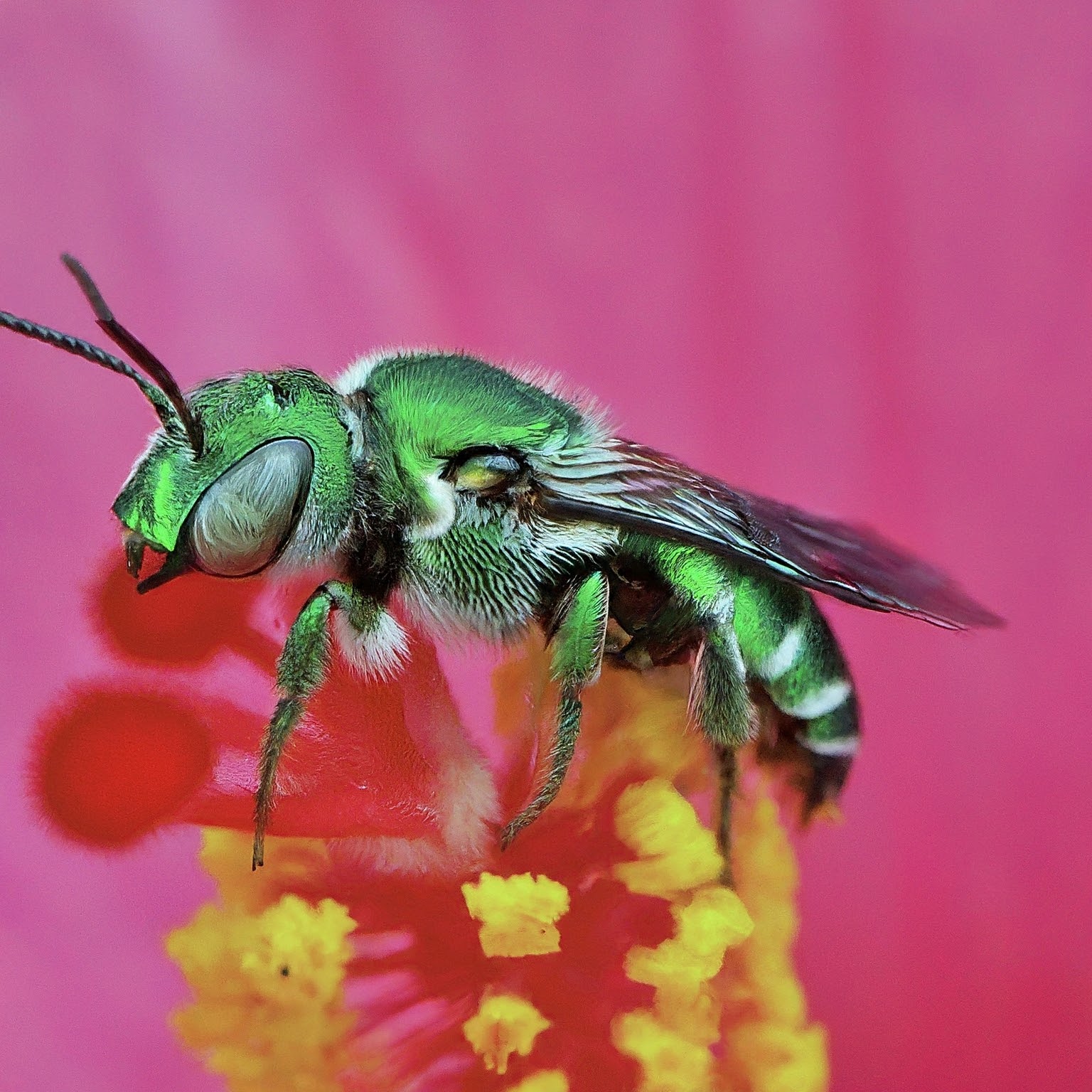The jungles of Belize teem with fascinating creatures, but some of the most vital players are surprisingly small. Often overshadowed by their honey-producing cousins, leafcutter bees buzz diligently throughout Belize’s diverse ecosystems. These solitary bees, unlike leafcutter ants, are gentle giants in the insect world. While they share the leaf-cutting habit, their purpose is entirely different, and their contribution to the delicate balance of Belize’s flora and fauna is nothing short of extraordinary.
Circular Craftsmanship: How Leafcutter Bees Build Their Homes
Imagine a bee meticulously snipping out perfect circles from leaves, carrying them back to a hidden chamber, and using them to construct a nursery for its offspring. This isn’t a scene from a whimsical story; it’s the remarkable reality of the leafcutter bee. In the lush rainforests and vibrant gardens of Belize, these solitary bees are master architects, crafting intricate nests using a unique technique.
Leafcutter bees, unlike their honeybee counterparts, don’t live in large hives. They’re solitary creatures, each female working tirelessly to build her own nest. The first step in this process is finding a suitable cavity. Leafcutter bees favor pre-existing holes in wood, abandoned beetle burrows, or even hollow stems. Once a location is chosen, the real artistry begins.
The bee sets out in search of the perfect building materials – leaves. With powerful mandibles, she meticulously snips out neat circles, typically around a quarter to half an inch in diameter. The preferred leaves are often soft and pliable, coming from plants like roses, hibiscus, and even some vegetables. Interestingly, the bee shows a remarkable sense of efficiency, often taking just a single, clean cut from each leaf.
Back at her chosen cavity, the bee goes to work constructing her nest. She uses her saliva as a natural glue, meticulously layering the circular leaf pieces to form a protective wall at the back of the chamber. This leafy wall serves multiple purposes – it provides insulation for the developing young, protects them from predators, and forms the foundation for the individual brood chambers within the nest.
Once the initial wall is complete, the bee embarks on another crucial task: provisioning. She collects pollen and nectar, mixing them into a nutritious paste that will serve as food for her offspring. This precious “bee bread” is then meticulously packed into the chamber, creating a perfect little pantry for the larva to develop. Finally, the bee lays a single egg on top of the pollen provisions, seals the chamber with another layer of leaf circles, and begins the process all over again, creating a series of these individual brood chambers within her nest.
The entire construction process showcases the remarkable ingenuity of the leafcutter bee. With a few simple tools – powerful mandibles, saliva as glue, and a keen eye for perfect circles – these solitary bees create safe havens for their young, ensuring the continuation of their vital role in Belize’s ecosystems.
Pollen Powerhouses: The Leafcutter Bee’s Contribution to Belize’s Biodiversity
While their circular leaf cuttings may be the most noticeable aspect of their lives, the true significance of leafcutter bees lies in their tireless work as pollinators. Unlike honeybees, which visit a wide variety of flowers throughout the day, leafcutter bees tend to be more specialized. They often focus on a specific type of flower, making them incredibly efficient at transferring pollen from one plant to another – a process crucial for plant reproduction.
Belize boasts a remarkable diversity of flowering plants, from the vibrant orchids of the rainforest canopy to the delicate wildflowers carpeting the Maya Mountains. Leafcutter bees play a vital role in ensuring the continued success of these plants. As they diligently collect pollen to provision their nests, they inadvertently become entangled in the flower’s pollen grains. These grains then hitch a ride on the bee’s body to the next flower of the same species, resulting in successful pollination.
This transfer of pollen is essential for plant reproduction. Without pollinators like leafcutter bees, many plants wouldn’t be able to produce fruits or seeds, leading to a decline in plant diversity and a ripple effect throughout the entire ecosystem. Leafcutter bees, with their specialized focus on specific flowers, are particularly adept at ensuring successful cross-pollination, the transfer of pollen between different plants of the same species. This cross-pollination leads to stronger, more resilient offspring in the plant population, further contributing to the overall health and biodiversity of Belize’s flora.
The impact of leafcutter bees extends beyond just ensuring plant reproduction. The fruits and seeds produced thanks to their pollination efforts become a vital food source for a wide range of animals, from birds and mammals to other insects. This creates a complex web of interconnectedness within the ecosystem, all dependent on the dedicated work of these tiny pollinators.
In conclusion, leafcutter bees are more than just skilled architects. They are silent guardians of Belize’s biodiversity, playing a crucial role in ensuring the health and productivity of the nation’s vibrant plant life. Their tireless pollination efforts form the foundation of a thriving ecosystem, showcasing the interconnectedness of all living things.
Beyond Honeybees: Why Leafcutter Bees Matter for Belize’s Ecosystems
While honeybees often take center stage when it comes to discussions about pollinators, Belize’s ecosystems rely heavily on a diverse cast of characters, including the unassuming leafcutter bee. Here’s why these solitary insects deserve recognition as vital players in maintaining the delicate balance of Belize’s environment.
Firstly, leafcutter bees are incredibly efficient pollinators. Unlike honeybees who visit a variety of flowers throughout the day, leafcutter bees tend to specialize on specific plant species. This focused approach allows them to develop a keen understanding of the flower’s structure, enabling them to quickly and effectively collect pollen. This targeted approach translates to a higher rate of successful pollen transfer between plants of the same species, ensuring healthy reproduction.
Secondly, leafcutter bees are active throughout a wider range of the day than honeybees. While honeybees primarily forage during the warm midday hours, leafcutter bees are often seen buzzing around even in the cooler morning and afternoon. This extended activity window allows them to pollinate a wider variety of plants that may bloom outside the peak foraging times of honeybees. This increased pollination activity benefits a broader range of plant species, contributing to the overall health and diversity of Belize’s flora.
Thirdly, the solitary nature of leafcutter bees offers a distinct advantage. Unlike honeybee hives, which can harbor diseases that can spread to plants, leafcutter bees pose a much lower risk. Their independent nests prevent the rapid transmission of pathogens, promoting a healthier relationship between pollinator and plant.
Finally, the presence of a diverse pollinator community, including leafcutter bees, fosters resilience within the ecosystem. If one pollinator species experiences a decline due to habitat loss or disease, others like leafcutter bees can step in and continue the crucial work of ensuring plant reproduction. This redundancy within the pollinator network helps to safeguard the long-term health of Belize’s ecosystems.
In conclusion, while honeybees are undeniably important, leafcutter bees are essential partners in Belize’s pollination dance. Their specialized behavior, extended activity window, solitary nature, and contribution to a diverse pollinator community all play a vital role in maintaining the vibrant tapestry of life within Belize’s ecosystems.
Final Thoughts
Leafcutter bees, with their meticulous leaf-cutting and tireless pollination efforts, are a shining example of the remarkable diversity and importance of solitary bees. Often overshadowed by their honey-producing cousins, these gentle giants play an essential role in the delicate balance of Belize’s ecosystems.
From their ingenious nest construction to their specialized pollination strategies, leafcutter bees showcase the power of nature’s intricate design. Their presence highlights the importance of protecting and promoting biodiversity, ensuring a healthy future not just for these fascinating creatures but for the entire web of life in Belize.
So, the next time you see a bee buzzing amongst the flowers, take a closer look. It might just be a leafcutter bee, a silent guardian diligently working to ensure the continued beauty and bounty of Belize’s natural world.




